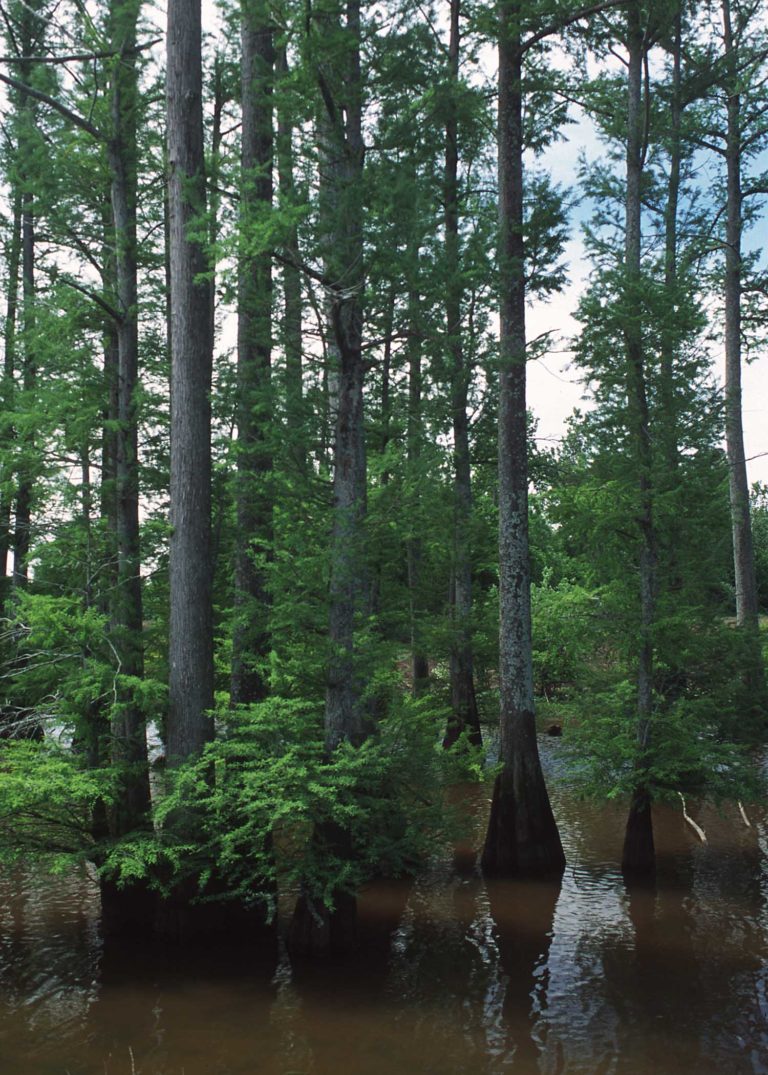Bald Cypress is a stately and long-lived deciduous conifer found throughout the swamps and riparian areas of the southeast, famous for its knobby “knees” and flared or buttressed trunks. It is important for most of us non-swamp dwellers, though, because Bald Cypress can also thrive in well drained upland soils. Since Bald Cypress relies on wetland conditions for seedling establishment, but thrives in upland soils once established, its cultivated range is much larger than its naturally occurring range. There is a lot of lore about this species. The trees are found in coastal riparian areas from southern Virginia down into Florida and over to East Texas, as well as in the southern Mississippi Valley. Floodwaters spread seeds along water courses, and germination occurs where soils are saturated but not flooded. It is commonly 70-80 feet tall and often taller, the tallest known being 145 feet tall (!) and the record DBH (diameter at breast height) being 17 feet!! (Wikipedia). These record measurements reflect the unusual longevity of the species, some of which are estimated to be more than 2,000 years old, as old as our Christian calendar! Normally, Bald Cypress tops out vertically at about 200 years, but continues to grow outward. The wood is valued for its natural resistance to rot, and of course Bald Cypress is a sought-after ornamental tree for its majestic form and its incredibly bright green, feathery spring foliage which shows coppery, rusty orange in fall.
NURSERY HOURS
Wednesday: 10-4 Thursday: 10-6 Friday-Saturday: 10-4 Sunday: 12-4
Taxodium distichum

Key Info
Scientific Name: Taxodium distichum (L.) Rich.
Common Names: Bald Cypress, Southern Bald Cypress, Swamp Cypress, Tidewater Red Cypress, White Cypress, Yellow Cypress, Gulf Cypress Deciduous Cypress
Family Names: Cupressaceae (Cypress Family)
Plant Type: Tree / Shrub
Leaf Retention: Deciduous
Bloom Times: n/a
Flower Color: This speces has cones rather than flowers.
Special Characteristics: Showy fruit, Good wildlife cover/habitat, Long lived, Drought tolerant, Excellent timber, Good fall color, Attracts birds, Tolerates wet conditions, Reported to be deer resistant.
Additional Info
Habit: Bald Cypress is a large tree with horizontal branching and a pyramid-shaped crown when young, becoming flat-topped as it ages. The trunk is usually, buttressed at the base and often reinforced with "knees", especially in water. The bark is fibrous, ridged and scaly. Stems are of two types: persistent stems are brownish and hold spirally-arranged needles and deciduous stems, and deciduous stems remain green and hold needles in 2-ranks, resembling pinnately compound leaves. There is a tap root as well as horizontal roots.
Height: up to 75'
Spread: up to 40'
Soil Conditions: Medium well drained, to wet, to standing water, acidic, prefers sandy soils but tolerates a wide range of soil conditions. Plants tolerate clay, loam, acid or alkaline pH, heat and some drought.
Leaves: Persistent stems are slender, with alternate, linear, flat leaf blades spirally arranged and round buds near the end; deciduous stems exhibit two ranks of needle-like leaves ¼ to 3⁄4 inch long, resembling pinnately compound leaves. The texture of the foliage is feathery.
Flowers (or reproductive structures: Bald Cypress is monoecious - has both male and female flowers on each tree. In late autumn, tiny purple male flowers grow in drooping clusters (catkins) up to 10 inches long at the ends of branches. Since Bald Cypress is deciduous, they are quite conspicuous in winter. Female flowers resemble small pine cones less than 2 inches in diameter. Called conelets, they are spherical, nearly sessile, single or in small clusters also at the ends of branches.
Fruit: The conelets consist of 9 to 18 overlapping, spirally arranged scales. When pollen is shed in March and April, each scale produces one or two triangular seeds. The female cones, 3⁄4 to 1 inch in diameter, mature from green to brownish purple in fall, and then disintegrate into irregular seeds that cover the ground..
Natural Distribution: Bald Cypress occurs mainly along rivers with alluvial flood deposits: swamps, stream banks, bayous, moist soils. More than 90 percent of the natural cypress stands are found on flat or nearly flat topography at elevations less than 100 feet above sea level in very wet soils consisting of muck, clay, or fine sand where moisture is abundant (U.S. Forest Service).
USDA Hardiness Zone: 4 to 10
USDA Wetland Indicator Status in NC: OBL
Pollination: Wind
Wildlife Connections: Birds use Bald Cypress trees for cover and for nesting sites. Seeds are a food source for birds and small mammals, such as wild turkey, wood ducks, evening grosbeak, and squirrels. Bald cypress seeds are eaten by Yellow-throated warblers that forage in the Spanish moss often found hanging on the branches of Bald Cypress trees in the South (U.S. Forest Service) It also provides habitat for insects, which further attract birds.
Propagation: Bald Cypress seedlings cannot compete with other vegetation in upland sites, and thus rely on the wetland environment for successful reproduction in the wild. However, stratified seeds will germinate abundantly in moist soil where competition is controlled.
